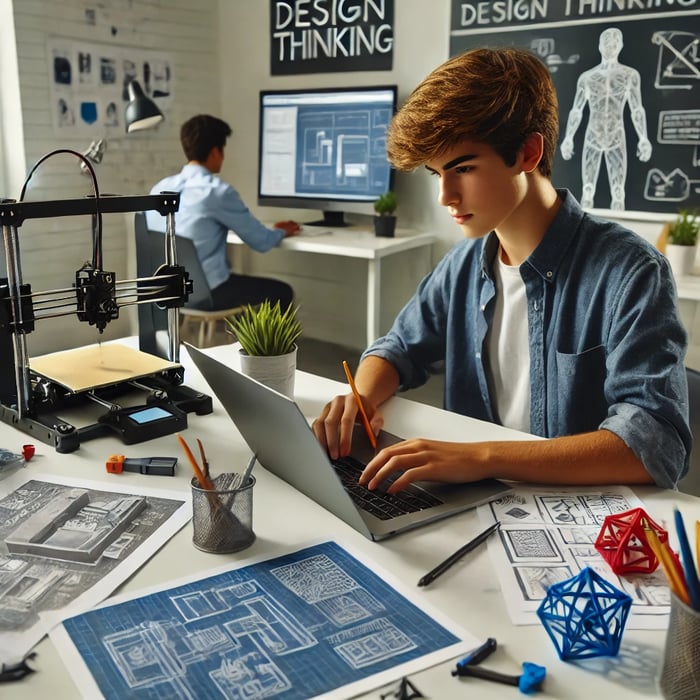Summary of the IB Diploma Programme Design Technology Guide (First Assessment 2027)
Overview
The IB DP Design Technology course is structured to develop students' problem-solving, innovation, and design-thinking skills. It focuses on analysis, design development, synthesis, and evaluation to foster critical thinking and hands-on application. The course integrates science, mathematics, and engineering principles to create innovative and practical solutions.
The curriculum is divided into three core components:
- Design in Theory (Fundamentals, design processes, user-centered approaches)
- Design in Practice (Prototyping, material selection, structural and mechanical systems)
- Design in Context (Ethics, sustainability, circular economy, product analysis)
The syllabus is designed to balance theoretical understanding with practical application, requiring students to develop a product design solution through an iterative process of modelling, prototyping, and testing.
Teacher Benefits
- Interdisciplinary Approach: The curriculum aligns with multiple disciplines, including science, engineering, and art, fostering cross-subject learning.
- Project-Based Learning: Emphasizes real-world applications, making learning engaging and relevant.
- Encourages Innovation: Supports design thinking methodologies that can be applied beyond the classroom.
- Prepares Students for STEM Careers: Provides students with a strong foundation in product design, engineering, and technology fields.
- Use of Modern Tools: Encourages the use of CAD software, rapid prototyping, AI tools, and hands-on prototyping methods.
- Global Perspectives: Promotes international-mindedness, sustainability, and ethical responsibility in design.
Challenges for Teachers
- Resource Intensive: Requires access to specialized software, tools, and materials for hands-on activities.
- Complex Assessment Model: Includes internal assessments, written exams, and project work, requiring structured guidance for students.
- Diverse Learning Needs: Students may have varying technical backgrounds and learning paces, requiring differentiated instruction.
- Ethical and Sustainability Considerations: Teachers need to integrate ethics, environmental impact, and sustainable design principles effectively.
- Keeping Up with Technology: Rapid advancements in AI, automation, and new manufacturing techniques mean educators must continuously update their knowledge.
Best Practices for Effective Teaching
Project-Based and Inquiry-Based Learning:
- Encourage student-led investigations and real-world problem-solving.
- Use case studies of existing products to analyze design failures and successes.
Hands-On Prototyping and Modelling:
- Integrate physical and digital modelling (e.g., CAD, 3D printing, simulations).
- Use interactive design workshops to foster creativity.
Cross-Disciplinary Integration:
- Connect design principles with physics (mechanics), biology (biomaterials), and environmental science (sustainability).
- Encourage students to explore design thinking methodologies used in business and tech industries.
Use of AI and Emerging Technologies:
- Guide students on ethical AI use for research, prototyping, and process optimization.
- Provide training in digital fabrication techniques.
Collaboration and Industry Exposure:
- Encourage group projects and team-based problem-solving.
- Partner with local businesses, design firms, or universities for guest lectures and real-world challenges.
Focus on Sustainability and Ethics:
- Teach circular economy principles and life-cycle analysis.
- Encourage eco-friendly material selection and energy-efficient design.
Structured Assessment Support:
- Provide clear rubrics for internal assessments.
- Use peer reviews and self-assessment for project improvements.
Assessment Structure
- External Assessments (60%)
- Paper 1 (20%): Multiple-choice and short-answer questions on design theory.
- Paper 2 (40%): Extended-response questions testing critical thinking and problem-solving.
- Internal Assessment (40%)
- Design Project: Students create a design solution, including problem identification, research, prototyping, and evaluation.
- Requires 50 hours of work, integrating primary and secondary research, iterative testing, and final presentation.
Conclusion
The IB DP Design Technology course prepares students for the rapidly evolving fields of engineering, product design, and sustainability. By using a hands-on, interdisciplinary approach, teachers can create engaging and impactful learning experiences that equip students with the critical skills needed for the future of design and technology. However, success in delivering this curriculum depends on access to resources, continuous learning, and innovative teaching strategies. Download Post

